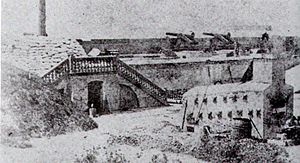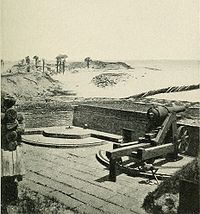| Fort Moultrie | |
|---|---|
| Part of Fort Sumter National Monument | |
| Sullivan's Island, South Carolina, U.S. | |
 Fort Moultrie in December 2006. The United States flag is at half-staff because of Gerald R. Ford's death. | |
 Fort Moultrie in 1861. | |
| Coordinates | 32°45′33.81″N 79°51′28.05″W / 32.7593917°N 79.8577917°WCoordinates: 32°45′33.81″N 79°51′28.05″W / 32.7593917°N 79.8577917°W |
| Site information | |
| Owner | National Park Service |
| Open to the public | Yes |
| Site history | |
| Built | 1776 |
| In use | 1776–1947 |
| Battles/wars | Battle of Sullivan's Island |

Confederate Fort Moultrie on Sullivan's Island looking east into Charleston Harbor

Fort Moultrie Visitor Center

Entrance to Fort Moultrie

Cannon displayed at Fort Moultrie
Fort Moultrie is the name of a series of citadels on Sullivan's Island, South Carolina, built to protect the city of Charleston, South Carolina. The first fort, built of palmetto logs, inspired the flag and nickname of South Carolina, "The Palmetto State". It is named for the commander in the Battle of Sullivan's Island, General William Moultrie.
Fort Moultrie is the only area of the National Park System where the entire 171-year history of American seacoast defense (1776–1947) can be traced.
History[]
American Revolution[]
South Carolina patriots began to build a fort to guard Charleston, South Carolina, harbor in 1776. British Admiral Sir Peter Parker with nine British warships attacked the fort—still unnamed and incomplete—on June 28, 1776, near the beginning of the American Revolutionary War. The soft palmetto logs did not crack under bombardment but rather absorbed the shot; cannonballs reportedly even bounced off the walls of the structure. William Moultrie, commander of the 2nd South Carolina Regiment, and his four hundred men fought a day-long battle that ended with the heavily damaged British ships being driven from the area. This victory galvanized the Patriots' cause for independence.[1] The fort hence took its name Fort Moultrie in his honor. Charleston locals celebrate "Carolina Day" to commemorate the bravery of the defenders of the fort. During this battle, the Moultrie flew a flag of his own design, authorized by the colonial government. It was later called the Moultrie flag or Liberty flag and became iconic to the Revolution in the South.
The British eventually captured Fort Moultrie as part of the Siege of Charleston in spring 1780. Nevertheless, the colonists won the war, and British troops departed in 1782, at which time the flag was presented in Charleston, by General Nathanael Greene, commander of the southern Regulars.
Early federal period[]
Great Britain and France began another war in 1793, heightening tensions. The United States of America thence embarked on a systematic fortification of important harbors. Atop the decayed original Fort Moultrie, the Army completed a new fort in 1798; the Army also built nineteen other new forts along the Atlantic coast. A hurricane destroyed Fort Moultrie in 1804, and a brick fort, the third and last such structure, replaced it in 1809. It had five hundred men in the garrison.[1] Fort Moultrie changed little over the next five decades. The Army altered the parapet and modernized the armament, but defense of Charleston centered increasingly around newly created Fort Sumter. By the time of the American Civil War, Fort Moultrie, Fort Sumter, Fort Johnson, and Castle Pinckney surrounded and defended Charleston. Fort Moultrie began to record meteorological observations in the early 1820s. The Army detained Seminole Indian fighter Osceola and some fellow Seminole prisoners at Fort Moultrie late 1837. Osceola died of malaria in January 1838; the Army buried his corpse at Fort Moultrie and thereafter maintained his grave.
Civil War[]
In the months leading up to the Civil War John L. Gardner was in command at Fort Moultrie. With secession growing more imminent Gardner had made several requests to Secretary of War John B. Floyd for more troops to garrison and defend the undermanned fortress. Each time his requests were ignored as the soon to be traitor Floyd was planning to hand the forts in Charleston Harbor over to the secessionists. South Carolina seceded from the Union on December 20, 1860. Unlike their counterparts at the other forts, defenders of Fort Moultrie chose not to surrender to the South Carolina forces. On December 26, 1860, Union Major Robert Anderson moved his garrison at Fort Moultrie to the stronger Fort Sumter. On February 8, 1861, South Carolina joined other seceded Deep Southern states to form the Confederate States of America. In April 1861, Confederate troops shelled Fort Sumter into submission and the American Civil War began. In April 1863, Federal ironclads and shore batteries began a bombardment of Fort Moultrie and the other forts around Charleston harbor. Over the ensuing twenty months, Union bombardment reduced Fort Sumter to a rubble pile and pounded Fort Moultrie below a sand hill, which protected it against further bombardment. The Rifled cannon proved its superiority to brickwork fortifications but not to the endurance of the Confederate artillerymen who continued to man Fort Moultrie. In February 1865, the Confederate Army finally abandoned the rubble of Fort Moultrie and evacuated the city of Charleston.
Postbellum period[]
The Army modernized Fort Moultrie in the 1870s with huge rifled cannon and deep concrete bunkers. Further modernization in the 1880s turned all of Sullivan's Island surrounding the old fort into a military complex. The fort evolved with the times through and beyond World War II. On August 15, 1947, the Army lowered Fort Moultrie's flag for the last time and ended 171 years of service. After the war, seacoast defense of the United States ceased to be a viable strategy.
Decommissioning[]
The Department of Defense in 1960 turned Fort Moultrie to National Park Service. NPS manages the historic fort as a unit of Fort Sumter National Monument.[2] NPS constructed the fort as a tour backward in time through its defenses from World War II to the original palmetto log fort constructed by William Moultrie. The National Register of Historic Places listed Fort Moultrie Quartermaster and Support Facilities Historic District on September 6, 2007.[3][4] In 2016, the "America the Beautiful" quarter for South Carolina will feature "Fort Moultrie (Fort Sumter National Monument)."
Moultrie is honored with his statue in The Battery section of downtown Charleston.
See also[]
Bibliography[]
- Detzer, David (2002
Houghton Mifflin Harcourt). Allegiance: Fort Sumter, Charleston, and the Beginning of the Civil War. p. 400. ISBN 9780156007412., Book (par view)
- Lossing, Benson John (1874). The Pictorial Field Book of the Civil War in the United States of America, Volume 1
Hartford. Thomas Belknap. p. 640., E'book
- Moore, Frank (1889). The Civil War in Song and Story, 1860–1865. P. F. Collier
New York. p. 560., E'book
- Wilson, James Grant; Fiske, John (1888). Appleton's Cyclopaedia of American Biography, Volume 2
D. Appleton and Company, New York., E'book
References[]
- ↑ 1.0 1.1 Fort Moultrie brochure, United States Department of the Interior, National Park Service
- ↑ National Park Service. "Fort Sumter National Monument Draft GMP/EA". http://www.nps.gov/fosu/parkmgmt/upload/FOSU_GMP_1998.pdf. Retrieved 2010-06-25. "The National Park Service accepted jurisdiction of Fort Moultrie in 1960 under authority of the Historic Sites Act of 1935 Pub.L. 74–292.", p.9.
- ↑ Schneider, David B. (March 6, 2007). "Fort Moultrie Quartermaster and Support Facilities Historic District" (pdf). National Register of Historic Places - Nomination and Inventory. http://www.nationalregister.sc.gov/charleston/S10817710178/S10817710178.pdf. Retrieved 10 June 2012.
- ↑ "Fort Moultrie Quartermaster and Support Facilities Historic District, Charleston County (Sullivan's Island)". National Register Properties in South Carolina. South Carolina Department of Archives and History. http://www.nationalregister.sc.gov/charleston/S10817710038/index.htm. Retrieved 10 June 2012.
External links[]
| Wikimedia Commons has media related to Fort Moultrie National Monument. |
- Fort Moultrie
- Historic Charleston's Religious and Community Buildings, a National Park Service Discover Our Shared Heritage Travel Itinerary
The original article can be found at Fort Moultrie and the edit history here.